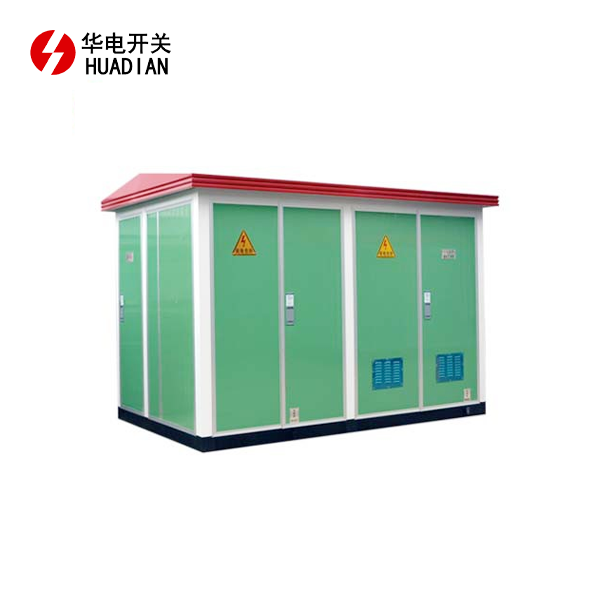
Principles and characteristics of box-type substation
2025-08-05 15:46:56
A box-type substation, often referred to simply as a box-type transformer, also has another name: an outdoor substation. It typically utilizes a three-phase oil-immersed power transformer, along with high and low voltage switches, energy metering, and lightning protection components. These components are strategically arranged and tightly connected, housed within a steel structure box for a harmonious and integrated experience. These substations combine substation, power distribution, and metering functions, occupying a small footprint and making installation easy. They are generally suitable for use in three-phase AC systems rated at 10/0.4 kV, serving as circuits and distributing power.

Principle of box-type substation
Compared to European-style box-type transformers of the same capacity, American-style box-type transformers have a more rational structure. Because European-style box-type transformers house the transformer and common high-voltage electrical equipment in a single metal enclosure, the transformer's room temperature is high, making heat dissipation difficult and impacting output. Furthermore, the box-type transformers utilize common high-voltage load switches, fuses, and low-voltage switchgear, resulting in a larger size. American-style box-type transformers differ structurally from European-style box-type transformers. Their low-voltage, transformer, and high-voltage compartments are arranged in a "pin" shape, rather than a "mu" shape. Structurally, these box-type transformers are divided into two sections: the front section houses the high- and low-voltage operating compartments, which contain the high- and low-voltage wiring terminals, the load switch operating handle, the off-load tap-changing switch, plug-in fuses, and an oil level gauge. The rear section houses the oil filling tank and heat sink, housing the transformer windings, core, high-voltage load switch, and fuses.
The arrester also uses an oil-immersed metal oxide arrester. The transformer eliminates the oil conservator and adopts a sealed oil tank designed based on the principle of constant oil-air gap volume. The oil tank and radiator are exposed to the air, eliminating heat dissipation issues. Molded case circuit breakers are used as the main and outgoing low-voltage circuit breakers. Due to its simplified structure, this box-type substation significantly reduces both floor space and volume. Due to its compact size and the fact that the door only opens on one side, it requires only one-quarter the floor space and one-fifth to one-third the volume of a European box-type substation of the same capacity. The high-voltage side of the American box-type substation is protected by fuses, while the low-voltage side is protected by molded case automatic air circuit breakers, similar to the protection scheme used for 10kV distribution transformers in China. The high-voltage fuse protects against internal transformer faults, while the automatic air circuit breaker protects the low-voltage line from overcurrent, short circuit, and undervoltage faults. However, the American box-type substation has disadvantages. Because the load switches are immersed in oil, the oil is carbonized and decomposed by the arc, producing harmful gases such as acetylene, which degrades performance and has caused accidents. The lack of a clear disconnect point makes maintenance inconvenient. Because low-voltage protection and metering methods differ between the US and China, American-style box-type transformers lack these features. To meet the needs of domestic users, domestic box-type transformers are equipped with a low-voltage distribution cabinet on the low-voltage side. Because box-type transformers are constantly exposed to direct sunlight, this affects the heat dissipation of the molded case circuit breaker, preventing it from properly interrupting loads and short-circuiting currents, potentially leading to high-voltage side failures.
Features
The box-type substation high-voltage switch is mainly composed of a multi-circulation system, armored bus and substation integrated automation system, communication, remote, measurement, and DC power supply capacitance compensation unit. It is installed in a steel structure that is resistant to moisture, rust, dust and rodents, heat-insulated, fire-proof, and anti-theft, and is closed and movable. It is mechatronic and operates in a closed manner. It has the following main features:
1. The substation's integrated automation equipment, installed using a microcomputer protection system, can implement the "four major controls": telemetry, remote communication, and remote control. Each unit should have independent operational functions and comprehensive protection features. Distance operating parameters can be set to control casing humidity, temperature, and smoke alarm distance, meeting unmanned operation requirements. Remote video monitoring can also be implemented as needed.
2. In terms of design, the designer typically determines the actual needs of the substation and then designs accordingly. The main wiring diagram and external box equipment are designed to meet manufacturer-provided specifications and models. Select boxes can be changed to modify the manufacturer's specifications and models. All equipment is installed and commissioned in the factory, ensuring compliance with the actual factory substation construction, shortening the design and manufacturing cycle. On-site installation only requires commissioning tasks such as box positioning, inter-box cable connections, outgoing line cable connections, protection calibration, and transmission testing. The entire substation takes only 5-8 days from installation to operation, significantly shortening the construction period.
Are you looking for high-quality box-type substation solutions? Shaanxi Huadian Electric Co., Ltd. provides products that meet or exceed international standards. We ensure that our products have excellent performance and reliability. To learn more about our products or discuss your specific needs, please contact us:pannie@hdswitchgear.com.
YOU MAY LIKE



